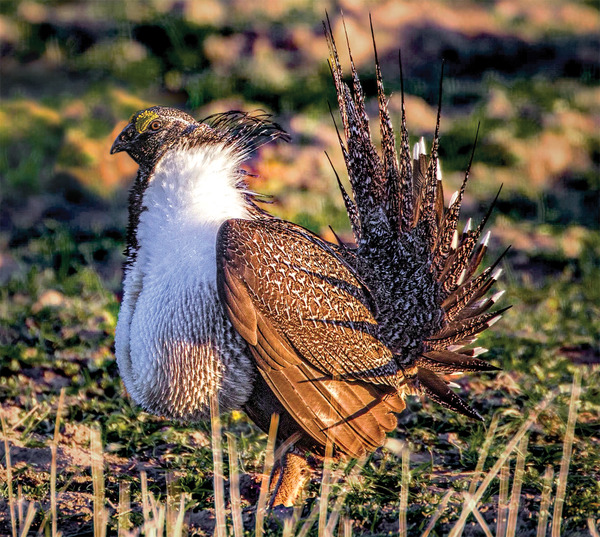The Local newsletter is your free, daily guide to life in Colorado. For locals, by locals.
This past April, I trekked through the rolling plains of northwestern Colorado, several miles outside the town of Craig, to watch a bird called the greater sage-grouse copulate in the half-light of dawn. My guide, a 44-year-old conservationist named Mark Salvo who works for the nonprofit Defenders of Wildlife in Washington, D.C., told me to be silent, dim my flashlight, and refrain from sudden movements. Sage-grouse, he said, are sensitive creatures, and their flamboyant courtship rituals are easily disturbed.
The birds, which look a little like overgrown chickens, had gathered in a flat open space in the sagebrush that ornithologists call a “lek,” ancestral ground to which the sage-grouse, if conditions are right, return each spring to dance, sing, and find mates. The males—we counted 148—puffed out their yellow chests and beat their wings, hopped and turned, and made weird popping noises. The few hens on hand—there were 47—stood judging the performances. “It’s like the singles scene on a Friday night at the bar,” Salvo whispered.
He said it’s possible the birds had been coming to this spot for decades. “They’ve been around since the Pleistocene era,” Salvo said. “There was a time when so many sage-grouse abounded they darkened the skies. They numbered in the millions.”
Today, the greater sage-grouse, whose range includes parts of 11 Western states, is among the region’s most imperiled native species. Oil and gas drilling, livestock grazing, and new roads, fences, pipelines, and utility corridors have degraded and fragmented huge swaths of the sagebrush steppe habitat the birds need to thrive. A study released by the Pew Charitable Trusts in April found that between 2007 and 2013, the population suffered a 56 percent decline. The Pew census did not measure total population—a scientifically tricky process—but instead counted breeding males, an indicator of population size. There were 48,641, according to the study, the lowest figure ever reported. Says Salvo: “It’s a path toward extinction.”
The Sage-Grouse is what ecologists call an indicator species; that is, the health of the populations reflects the health of the sagebrush steppe, which covers 40 percent of the West. The idea, Salvo explains, is that if you conserve and protect sage-grouse habitat, you’ll end up benefiting hundreds of other plants and animals. Scientists have identified 350 species of concern in the sagebrush steppe, 60 of which are either already listed or are candidates for protection under the Endangered Species Act (ESA). Elk and mule deer use the habitat as winter feeding grounds. The steppe’s rivers and streams host rare trout, and more than 200 bird species spend time in the biome during their life cycles.
This month, by a court-approved deadline of September 30, the U.S. Fish and Wildlife Service will release a finding on whether it believes the greater sage-grouse warrants federal ESA protection. And for the moment, that’s as far as the agency will go on the issue. Last December, Congress attached a rider—which expires October 2016—onto a budget bill that prohibits the U.S. Fish and Wildlife Service from actually “writing” or “issuing” a proposed listing of the greater sage-grouse as threatened or endangered. (The agency could write and issue a not-warranted finding.)
Still, the possibility of an ESA listing has prompted Western states to argue that the bird can survive without federal protection, in part because a listing would mandate strict regulations that make oil and gas drilling more difficult. There would also be more conditions attached to the permits energy projects are required to get from the U.S. Bureau of Land Management (BLM), which controls most of the public land in Colorado where valuable oil and gas deposits are found.
Western Energy Alliance, a regional industry advocacy organization, estimates the oil and natural gas industry in Colorado, Wyoming, Montana, and Utah would lose between 9,170 and 18,250 jobs, and economic growth would be reduced by between $2.4 and $4.8 billion. (The Colorado Oil and Gas Association says its industry provides $29 billion in economic output and 111,000 jobs across the state.) “The Western Energy Alliance’s position is that a listing is not necessary,” says vice president of government and public affairs Kathleen Sgamma. “State and local efforts are protecting the bird, and we believe that more time should be given to those efforts.”
Clait E. Braun, a sage-grouse expert and former Colorado Division of Wildlife research biologist who now runs a consulting firm, Grouse Inc., singles out oil and gas as the chief threat to the bird. “The industry,” Braun says, “has by far had the largest most recent detrimental impacts on sage-grouse, through lax regulatory management, inadequate and improper construction restrictions, and outright long-term destruction of sagebrush steppe vegetation.”
The BLM is finalizing a sage-grouse management plan to help avert a U.S. Fish and Wildlife listing. The plan would prohibit drilling anywhere within a few miles of leks or the adjacent nesting grounds of hens in certain “Sagebrush Focal Areas.” And Colorado has drafted its own management protocols after more than a decade of consultation and study. Still, Salvo says the state “has been reluctant to adopt effective measures when it comes to sage-grouse conservation.”
In May, Governor John Hickenlooper issued an executive order expanding a state-led conservation plan for the greater sage-grouse that was initially developed in 2008, three years after the U.S. Fish and Wildlife Service had determined that listing the greater sage-grouse on the ESA was not warranted. The executive order promises, among other initiatives, a review of existing state oil and gas regulations on sage-grouse habitat and better record-keeping of habitat changes that are results of development.
The plan also establishes the Colorado Habitat Exchange, a “voluntary, market-driven program” to “mitigate residual impacts of development.” The exchange provides a market where oil and gas companies could—should they choose that option—pay into a mitigation fund to meet the state requirements. In all, since 2000, the state has spent roughly $62 million on sage-grouse conservation and research efforts for the greater sage-grouse, including “land protection, population and habitat monitoring, habitat treatments, [and] restoration.”
Sage-grouse conservationist Erik Molvar, director of the Sagebrush Sea Campaign, a nonprofit dedicated to preserving sage-grouse habitat, is critical of the governor’s latest plan—in particular, the fact that participation in the mitigation fund is voluntary. “It is devoid of any measurable, enforceable, science-based protections that would prevent additional impacts to sage-grouse,” Molvar says. “Without solid protections and an enforcement apparatus, you can’t build an endangered species recovery.”
Molvar also notes that Colorado, among the 11 sage-grouse states, is the only one that refused to supply sage-grouse population data for the 2015 Pew study. “Colorado Parks and Wildlife denied our requests for results of lek counts on four separate occasions,” wrote study co-author Edward O. Garton, professor emeritus of fish and wildlife and statistics at the University of Idaho. “This lack of cooperation makes it impossible to provide any improved estimates or discussion of changes from 2007 to 2013 [in Colorado].” Jeff Ver Steeg, assistant director for research, policy, and planning at Colorado Parks and Wildlife, says the agency did not participate because it had concerns with the soundness of Garton’s methodology.
Ver Steeg also argues sage-grouse conservation in northwest Colorado has been successful. “All indications are that populations are increasing,” he says. “From 2013 to 2014, the number of males on leks increased 23 percent.” Ver Steeg refers to a preliminary state report dated June 2015 that shows the count of males on leks up 50 percent from the previous year and up 72 percent when compared to the three-year average.
However, both Molvar and Braun (who are involved in litigation against the U.S. Fish and Wildlife Service regarding a recent decision not to list the Gunnison sage-grouse) say they have not seen any documentary evidence that state measures to protect the sage-grouse and its habitat have resulted in an increase in sage-grouse numbers. In particular, Braun criticizes Colorado Parks and Wildlife for only providing large-scale, area-wide counts, so-called “aggregated data,” for public review. “It would be almost impossible for someone to say, ‘This population is on the verge of extirpation,’ or, ‘That population could be expected to be completely gone in 20 years,’?” Braun says. “Aggregate totals mask the truth about small populations.”
Ver Steeg says the department used to release site-specific lek counts before 2005. That year, he says, a change in the law prohibited state agencies from releasing any information about sage-grouse counts that might compromise the privacy of landowners.
When dawn broke at the lek outside Craig last spring, Salvo surveyed the scene and made a count of the males and hens. The numbers had dropped as the hens mated and flew away. Only a small number of the males, sometimes less than three percent, will actually get to mate. Scientists have counted a single male mating 37 times with 37 females in 37 minutes. Some have been known to, over time, die of exhaustion.
Suddenly, the birds spooked. A northern harrier had dive-bombed them, which sent an antelope in their midst running, and four elk crested a distant ridgeline. It was a spectacular sight. The birds gathered again once the threat had passed and continued to pair up and mate, until no hens were left and a lot of males stood around looking bewildered, as if they were uncertain about what to do next.









